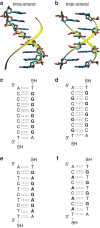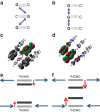Piezoresistivity in single DNA molecules
- PMID: 26337293
- PMCID: PMC4569700
- DOI: 10.1038/ncomms9032
Piezoresistivity in single DNA molecules
Abstract
Piezoresistivity is a fundamental property of materials that has found many device applications. Here we report piezoresistivity in double helical DNA molecules. By studying the dependence of molecular conductance and piezoresistivity of single DNA molecules with different sequences and lengths, and performing molecular orbital calculations, we show that the piezoresistivity of DNA is caused by force-induced changes in the π-π electronic coupling between neighbouring bases, and in the activation energy of hole hopping. We describe the results in terms of thermal activated hopping model together with the ladder-based mechanical model for DNA proposed by de Gennes.
Figures





Similar articles
-
Effect of mechanical stretching on DNA conductance.ACS Nano. 2015 Jan 27;9(1):88-94. doi: 10.1021/nn506280t. Epub 2014 Dec 31. ACS Nano. 2015. PMID: 25530305
-
Large and Pressure-Dependent c-Axis Piezoresistivity of Highly Oriented Pyrolytic Graphite near Zero Pressure.Nano Lett. 2024 Mar 25. doi: 10.1021/acs.nanolett.4c00687. Online ahead of print. Nano Lett. 2024. PMID: 38525903
-
Physical model for recognition tunneling.Nanotechnology. 2015 Feb 27;26(8):084001. doi: 10.1088/0957-4484/26/8/084001. Epub 2015 Feb 3. Nanotechnology. 2015. PMID: 25650375 Free PMC article.
-
Piezoresistivity and AC Impedance Spectroscopy of Cement-Based Sensors: Basic Concepts, Interpretation, and Perspective.Materials (Basel). 2023 Jan 12;16(2):768. doi: 10.3390/ma16020768. Materials (Basel). 2023. PMID: 36676505 Free PMC article. Review.
-
Spin polarized electron tunneling and magnetoresistance in molecular junctions.Top Curr Chem. 2012;312:275-302. doi: 10.1007/128_2011_223. Top Curr Chem. 2012. PMID: 21809185 Review.
Cited by
-
Double-Gated Nanohelix as a Novel Tunable Binary Superlattice.Nanoscale Res Lett. 2019 Aug 26;14(1):257. doi: 10.1186/s11671-019-3069-9. Nanoscale Res Lett. 2019. PMID: 31448386 Free PMC article.
-
Controlling piezoresistance in single molecules through the isomerisation of bullvalenes.Nat Commun. 2023 Oct 3;14(1):6089. doi: 10.1038/s41467-023-41674-z. Nat Commun. 2023. PMID: 37789027 Free PMC article.
-
Investigation on Single-Molecule Junctions Based on Current⁻Voltage Characteristics.Micromachines (Basel). 2018 Feb 2;9(2):67. doi: 10.3390/mi9020067. Micromachines (Basel). 2018. PMID: 30393343 Free PMC article. Review.
-
DNA-Based Single-Molecule Electronics: From Concept to Function.J Funct Biomater. 2018 Jan 17;9(1):8. doi: 10.3390/jfb9010008. J Funct Biomater. 2018. PMID: 29342091 Free PMC article. Review.
-
Large Conductance Variations in a Mechanosensitive Single-Molecule Junction.Nano Lett. 2018 Sep 12;18(9):5981-5988. doi: 10.1021/acs.nanolett.8b02810. Epub 2018 Aug 27. Nano Lett. 2018. PMID: 30134105 Free PMC article.
References
-
- Xu B., Xiao X. & Tao N. J. Measurements of single-molecule electromechanical properties. J. Am. Chem. Soc. 125, 16164–16165 (2003). - PubMed
-
- Diez-Perez I. et al.. Controlling single-molecule conductance through lateral coupling of π orbitals. Nat. Nanotechnol. 6, 226–231 (2011). - PubMed
-
- Bruot C., Hihath J. & Tao N. Mechanically controlled molecular orbital alignment in single molecule junctions. Nat. Nanotechnol. 7, 35–40 (2012). - PubMed
-
- Rascón-Ramos H., Artés J. M., Li Y. & Hihath J. Binding configurations and intramolecular strain in single-molecule devices. Nat. Mater. 14, 1–6 (2015). - PubMed
-
- Rajski S. R., Jackson B. A. & Barton J. K. DNA repair: models for damage and mismatch recognition. Mutat. Res. 447, 49–72 (2000). - PubMed
Publication types
MeSH terms
Substances
LinkOut - more resources
Full Text Sources
Other Literature Sources
Molecular Biology Databases
Research Materials
Miscellaneous

